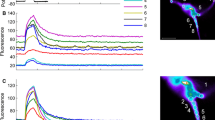Abstract
Digital imaging of fura-2 fluorescence and the voltage-clamp technique were combined to study cytoplasmic free Ca2+ concentration, [Ca]i, in neurons cultured from chick dorsal root ganglia. Depolarizing pulses raised [Ca]i to a new steady-state level which was achieved earlier in neurites than in the soma. The rise in [Ca]i during stimulated bursting or rhythmic activity was also faster in neurites. After stimulation [Ca]i recovered monoexponentially in the soma and biexponentially in neurites. Application of 50 mM KCl produced membrane depolarization and a concomitant increase of [Ca]i. During wash-out [Ca]i often declined to an intermediate steady-state level at which it stayed for several minutes. Thereafter the resting level of [Ca]i was quickly restored. [Ca]i recovery was delayed after treating the cell with 2 μM thapsigargin, an inhibitor of the Ca2+ pump of internal Ca2+ stores. Caffeine (10 mM) transiently increased [Ca]i. A second caffeine application produced smaller [Ca]i changes due to the prior depletion of Ca2+ stores, which could be replenished by brief exposure to KCl. Thapsigargin (2 μM) transiently increased [Ca]i both in the standard and Ca2+-free solution. [Ca]i transients due to caffeine and thapsigargin started in the cell interior, in contrast to [Ca]i changes evoked by membrane depolarization, which were noticed first at the cell edge. Caffeine and thapsigargin induced a transient inward current which persisted in the presence of 1 mM La3+ and in Ca2+-free solutions, but which was greatly diminished in Na+-free solutions. The effects of caffeine and thapsigargin were mutually exclusive both in the generation of [Ca]i transients and in the inward current induction.
Similar content being viewed by others
References
Ahmed Z, Connor JA (1979) Measurement of calcium influx under voltage clamp in molluscan neurons using the metal-lochromic dye Arsenazo III. J Physiol (Lond) 286:61–82
Barde Y, Edgar D, Thoenen H (1980) Sensory neurons in culture: changing requirements for survival factors during embryonic development. Proc Natl Acad Sci USA 77:1199–1203
Carbone E, Lux HD (1987) Kinetics and selectivity of low voltage-activated calcium current in chick and rat sensory neurones. J Physiol (Lond) 386:547–570
Duchen MR, Valdeomillos M, O'Neill SC, Eisner DA (1990) Effects of metabolic blockade on the regulation of intracellular calcium in dissociated mouse sensory neurones. J Physiol (Lond) 424:411–426
Friel DD, Tsien RW (1992) A caffeine- and ryanodine-sensitive Ca2+ store in bullfrog sympathetic neurones modulates effects of Ca2+ entry on [Ca2+]i. J Physiol (Lond) 450:217–246
Gorman A, Thomas M (1978) Changes in the intracellular concentration of free calcium ions in a pacemaker neuron measured with the metallochromic indicator dye Arsenazo III. J Physiol (Lond) 275:357–364
Gryrikiewicz G, Poenie M, Tsien RY (1985) A new generation of Ca2+ indicators with greatly improved fluorescence properties. J Biol Chem 260:3440–3450
Henzi V, MacDermott AB (1992) Characteristics and function of Ca2+ and inositol-1,4,5-triphosphate releasable stores of Ca in neurons. Neuroscience 46:251–273
Hernandez-Cruz A, Sala F, Adams PR (1990) Subcellular calcium transients visualized by confocal microscopy in a voltage-clamped vertebrate neuron. Science 247:858–862
Hofmeier G, Lux HD (1981) The time courses of intracellular free calcium and related electrical effects after injection of CaCl2 into neurons of the snail, Helix pomatia. Pflügers Arch 391:242–251
Horn R, Marty A (1988) Muscarinic activation of ionic currents measured by a new whole-cell recording method. J Gen Physiol 92:145–159
Jackson T, Patterson S, Thastrup O, Hanley M (1988) A novel tumor promoter, thapsigargin, transiently increases cytoplasmic free Ca2+ without generation of inositol phosphates in NG115-40/L neuronal cells. Biochem J 253:81–86
Jaffe DB, Johnston D, Lasser-Ross N, Lisman JE, Miyakawa H, Ross WN (1992) The spread of Na+ spikes determines the pattern of dendritic Ca2+ entry into hippocampal neurons. Nature 357:244–248
Kostyuk PG, Mironov SL, Tupikin AV, Belan PV (1989) Cytoplasmic free Ca in isolated snail neurons as revealed by fluorescent probe fura-2. Mechanisms of Ca recovery after Ca load and Ca release from interacellular stores. J Membr Biol 110:11–18
Kuba K, Nishi S (1976) Rhythmic hyperpolarization and depolarization of sympathetic ganglion cells induced by caffeine. J Neurophysiol 39:547–563
Lipscombe D, Madison D, Poenie M, Reuter H, Tsien RY, Tsien RW (1988) Spatial distribution of calcium channels and cytosolic calcium transients in growth cones and cell bodies of sympathetic neurons. Proc Natl Acad Sci USA 85:2398–2402
Miller RJ (1991) The control of neuronal Ca2+ homeostasis. Prog Neurobiol 37:255–285
Mironov SL (1993) Spatiotemporal inhomogeneity of [Ca]i in neurons. In: Dirnagl U, et al. (eds) Optical imaging of brain function. Plenum Press, New York (in press)
Mironov SL, Usachev JM (1991) Caffeine affects Ca2+ uptake and Ca2+ release from intracellular stores. Neurosci Lett 123:200–202
Müller W, Connor JA (1991) Cholinergic input uncouples Ca2+ changes from K+ conductance activation and amplifies intradendritic Ca2+ changes in hippocampal neurons. Neuron 6:901–905
Neering IR, McBurney RN (1984) Role for microsomal Ca storage in mammalian neurones? Nature 309:158–160
Neher E, Augustine GJ (1992) Calcium gradients and buffers in bovine chromaffin cells. J Physiol (Lond) 450:273–301
Rall W (1969) Core conductor theory and cable properties of neurons. In: Kandel ER (ed) Handbook of physiology. 1. The nervous system. American Physiological Society, Bethesda, pp 37–97
Shuttleworth TJ, Thompson JL (1991) Effect of temperature on receptor-activated changes in [Ca2+]i and their determination using fluorescent probes. J Biol Chem 266:1410–1414
Thayer SA, Miller RJ (1990) Regulation of the intracellular free calcium concentration in single rat dorsal root ganglion neurones in vitro. J Physiol (Lond) 425:85–115
Thayer SA, Hirning LD, Miller R (1988) The role of caffeine-sensitive calcium stores in the regulation of the intracellular free calcium concentration in rat sympathetic neurons in vitro. Mol Pharmacol 34:664–673
Tsien RW, Tsien RY (1990) Ca channels, stores, and oscillations. Annu Rev Cell Biol 6:715–760
Vogel Z, Sytkowski AJ, Nirenberg MW (1972) Acetylcholine receptors of muscle grown in vitro. Proc Natl Acad Sci USA 69:3180–3184
Author information
Authors and Affiliations
Rights and permissions
About this article
Cite this article
Mironov, S.L., Usachev, Y.M. & Lux, H.D. Spatial and temporal control of intracellular free Ca2+ in chick sensory neurons. Pflugers Arch. 424, 183–191 (1993). https://doi.org/10.1007/BF00374610
Received:
Revised:
Accepted:
Issue Date:
DOI: https://doi.org/10.1007/BF00374610




